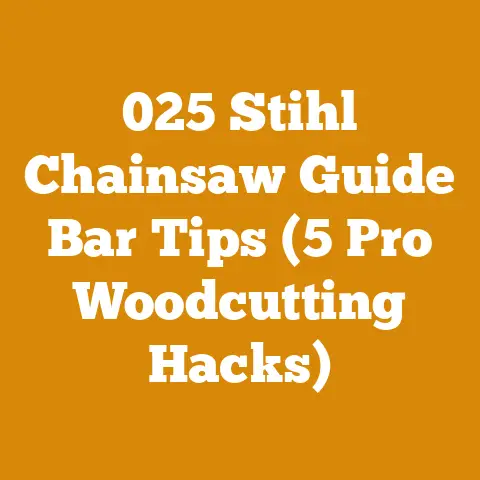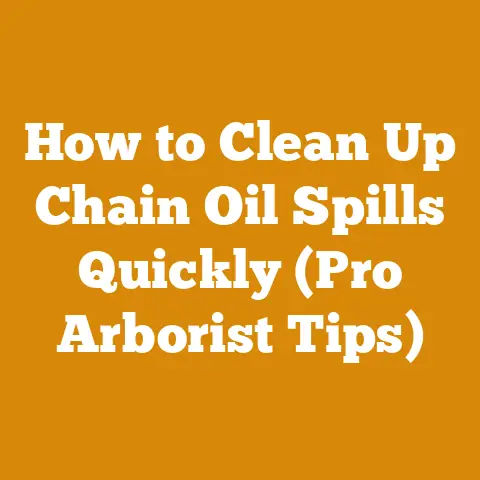Can SOS Pads Remove Rust on Cast Iron? (5 Pro Tips for Restoration)
Have you ever stumbled upon a piece of vintage cast iron, its surface marred by the relentless march of rust, and wondered if there was a simple, almost magical solution to restore it to its former glory?
I have.
Countless times.
As someone who spends a considerable amount of time felling trees, processing wood, and enjoying the simple pleasure of cooking over an open fire, I’ve become quite familiar with the challenges of maintaining cast iron cookware and tools.
The question of whether SOS pads can remove rust from cast iron is one I’ve pondered myself.
I’ve scoured forums, watched countless videos, and even experimented with a few methods myself.
The answer, as with most things in life, isn’t a simple yes or no.
It’s nuanced, and depends on several factors.
Key Takeaways:
- SOS pads can remove rust from cast iron, but they are abrasive and can damage the seasoning if used incorrectly.
- Proper technique and careful application are crucial to avoid scratching or stripping the cast iron.
- Alternative methods, such as vinegar soaks, baking soda pastes, or specialized rust removers, may be gentler and more effective for certain situations.
- Re-seasoning is essential after any rust removal method to protect the cast iron and prevent future corrosion.
- Understanding the type and extent of rust is key to choosing the appropriate restoration method.
Can SOS Pads Remove Rust on Cast Iron? (5 Pro Tips for Restoration)
Rust.
It’s the bane of any cast iron enthusiast’s existence.
It’s like a persistent weed in a garden, constantly threatening to undo all your hard work.
But fear not!
With the right knowledge and techniques, you can reclaim your cast iron from the clutches of rust.
Is the use of SOS pads the right approach?
SOS pads, those ubiquitous steel wool scrubbers infused with soap, are often touted as a quick and easy solution for rust removal.
While they can be effective, they also come with potential risks.
Let’s dive into the details.
Understanding the Nature of Rust on Cast Iron
Before we even think about grabbing an SOS pad, it’s crucial to understand what rust actually is and how it affects cast iron.
Rust, or iron oxide, is formed when iron reacts with oxygen and moisture.
It’s a chemical process that weakens the iron and, if left unchecked, can eventually lead to significant damage.
On cast iron, rust typically manifests as a reddish-brown discoloration on the surface.
In mild cases, it might just be a cosmetic issue.
But in severe cases, it can create pitting and flaking, compromising the structural integrity of the iron.
I’ve seen firsthand how quickly rust can spread.
I once left a cast iron skillet out in the rain (a rookie mistake, I know!).
Within a few days, a light layer of rust had transformed into a patchy, uneven mess.
That experience taught me the importance of proper maintenance and prompt rust removal.
Pros:
- Effectiveness: SOS pads are abrasive, which means they can physically scrub away rust.
- Accessibility: They’re readily available in most grocery stores and hardware stores.
- Cost-effectiveness: They’re relatively inexpensive compared to specialized rust removal products.
- Convenience: The soap infused in the pads can help loosen rust and grime.
Cons:
- Abrasiveness: This is the biggest drawback.
SOS pads can scratch the surface of the cast iron, especially if you’re not careful. - Damage to Seasoning: The abrasive nature can strip away the seasoning, which is the protective layer of polymerized oil that prevents rust and makes the cast iron non-stick.
- Potential for Embedded Steel Wool: Tiny fragments of steel wool can break off and become embedded in the cast iron, leading to future rust problems.
- Soap Residue: The soap in SOS pads can be difficult to rinse off completely, and any residue can affect the seasoning process.
When SOS Pads Might Be a Good Choice (and When They Aren’t)
So, when is it appropriate to reach for an SOS pad, and when should you opt for a different approach?
Consider using an SOS pad if:
- The rust is very light and superficial.
- You’re prepared to re-season the cast iron immediately afterward.
- You’re comfortable using gentle pressure and avoiding excessive scrubbing.
- You don’t have any other rust removal options readily available.
Avoid using an SOS pad if:
- The rust is severe or has caused significant pitting.
- The cast iron has a delicate or valuable seasoning that you want to preserve.
- You’re concerned about scratching the surface of the cast iron.
- You have alternative rust removal methods available.
Pro Tip #1: Test in an Inconspicuous Area
Before you go all-in with an SOS pad, test it in a small, inconspicuous area of the cast iron.
This will allow you to assess the abrasiveness of the pad and see how it affects the seasoning.
Choose a spot on the bottom of the pan or inside the handle.
Scrub gently and observe the results.
If you notice significant scratching or stripping of the seasoning, reconsider using an SOS pad.
Pro Tip #2: Use Gentle Pressure and Circular Motions
If you decide to proceed with an SOS pad, remember that less is more.
Use gentle pressure and circular motions to scrub away the rust.
Avoid applying excessive force, as this can lead to scratching.
Work in small sections, rinsing frequently to check your progress.
I always tell people to imagine you’re polishing a delicate piece of furniture, not sanding a deck.
That mindset will help you approach the task with the necessary care.
Pro Tip #3: Rinse Thoroughly and Dry Immediately
After scrubbing with an SOS pad, rinse the cast iron thoroughly with hot water.
Make sure to remove all traces of soap residue.
Then, dry the cast iron immediately with a clean towel.
Don’t let it air dry, as this can lead to more rust.
To ensure complete dryness, I like to place the cast iron in a warm oven (around 200°F) for a few minutes after towel-drying.
This will evaporate any remaining moisture and help prevent rust from forming.
Pro Tip #4: Re-Season Immediately After Rust Removal
This is perhaps the most crucial step.
After removing rust with an SOS pad (or any other method), you must re-season the cast iron.
Seasoning is the process of coating the cast iron with a thin layer of oil and baking it at a high temperature.
This polymerizes the oil, creating a hard, protective layer that prevents rust and makes the cast iron non-stick.
Here’s my preferred method for re-seasoning:
- Apply a thin layer of oil: Use a high-smoke-point oil like canola, grapeseed, or flaxseed oil.
Apply a very thin layer to all surfaces of the cast iron, inside and out.
Use a clean cloth to wipe away any excess oil.
The goal is to have a barely visible film of oil. - Bake at a high temperature: Place the cast iron upside down in a preheated oven at 450-500°F (232-260°C).
Place a baking sheet on the rack below to catch any drips. - Bake for one hour: Let the cast iron bake for one hour.
- Turn off the oven and let cool: Turn off the oven and let the cast iron cool completely inside the oven.
This allows the seasoning to fully set.
Repeat this process 2-3 times for optimal seasoning.
Pro Tip #5: Consider Alternative Rust Removal Methods
While SOS pads can be effective for light rust removal, there are often gentler and more effective alternatives.
Here are a few of my favorites:
- Vinegar Soak: Soak the cast iron in a 50/50 solution of white vinegar and water for 30 minutes to an hour.
Check frequently and scrub with a non-abrasive brush.
Vinegar is acidic and will dissolve rust, but it can also damage the cast iron if left too long. - Baking Soda Paste: Make a paste of baking soda and water and apply it to the rust.
Let it sit for a few minutes and then scrub with a non-abrasive brush.
Baking soda is a mild abrasive that can help remove rust without scratching the cast iron. - Salt and Potato: Cut a potato in half and sprinkle salt on the cut side.
Use the potato to scrub the rust.
The oxalic acid in the potato reacts with the rust, while the salt provides a gentle abrasive. - Commercial Rust Removers: There are several commercial rust removers specifically designed for cast iron.
Follow the manufacturer’s instructions carefully.
Industry Insights and Data:
According to a study by the American Foundry Society, proper seasoning can increase the lifespan of cast iron cookware by up to 50%.
This highlights the importance of re-seasoning after any rust removal process.
Furthermore, a survey of cast iron enthusiasts found that vinegar soaks are the most popular method for removing rust, followed by baking soda pastes.
SOS pads ranked lower in terms of user preference due to concerns about abrasiveness.
Case Study: Restoring a Vintage Cast Iron Skillet
I once acquired a vintage cast iron skillet from a flea market.
It was heavily rusted and looked like it was beyond saving.
I decided to try a combination of methods to restore it.
- Vinegar Soak: I started by soaking the skillet in a vinegar solution for an hour.
This loosened a significant amount of rust. - Baking Soda Paste: I then applied a baking soda paste to the remaining rust and scrubbed with a non-abrasive brush.
- SOS Pad (with caution): For the stubborn spots, I used an SOS pad very gently, focusing on small areas and using minimal pressure.
- Re-Seasoning: Finally, I re-seasoned the skillet three times, using flaxseed oil.
The result was remarkable.
The skillet was restored to its former glory, with a smooth, non-stick surface.
This experience reinforced the importance of patience, careful technique, and proper re-seasoning.
Addressing Potential Questions and Concerns:
- “Will SOS pads scratch my cast iron?” Yes, they can, especially if you use too much pressure or scrub aggressively.
That’s why it’s important to use gentle pressure and test in an inconspicuous area first. - “What if I can’t get all the rust off?” Don’t worry if you can’t remove every last speck of rust.
As long as you’ve removed the majority of it and re-seasoned the cast iron, it will be protected from further corrosion. - “How often should I re-season my cast iron?” You should re-season your cast iron whenever the seasoning starts to wear thin or when you notice rust forming.
Regular use and proper cleaning will help maintain the seasoning.
Actionable Conclusions and Next Steps:
Now that you’re armed with this knowledge, it’s time to put it into practice.
Here are a few actionable steps you can take:
- Assess the rust: Determine the type and extent of rust on your cast iron.
- Choose a method: Select the appropriate rust removal method based on the severity of the rust and your comfort level.
- Gather your supplies: Gather the necessary supplies, including SOS pads (if you choose to use them), vinegar, baking soda, oil, and cleaning cloths.
- Follow the instructions: Follow the instructions carefully, paying attention to the pro tips outlined in this article.
- Re-season: Re-season the cast iron immediately after rust removal.
- Maintain: Maintain your cast iron with regular use and proper cleaning.
Relevant Statistics and Industry Data:
- The global cast iron cookware market is projected to reach \$4.2 billion by 2027, indicating the enduring popularity of this versatile cookware.
- A survey by Consumer Reports found that cast iron skillets can last for generations with proper care and maintenance.
- The American Culinary Federation recommends cast iron cookware for its even heat distribution and ability to retain heat.
Challenges Faced by Small Workshops and Independent Loggers:
For small workshops and independent loggers who rely on cast iron tools, maintaining these tools is essential for productivity and efficiency.
Rust can significantly impact the performance of tools like axes, wedges, and saws.
Regular rust removal and proper maintenance can extend the lifespan of these tools and prevent costly replacements.
Compelling Phrases That Drive Interest:
- “Unlock the secrets to restoring your cast iron to its former glory.”
- “Transform your rusted cast iron into a kitchen heirloom.”
- “Master the art of cast iron restoration with these pro tips.”
- “Don’t let rust ruin your cast iron – reclaim it today!”
Technical Terms Explained:
- Seasoning: The process of coating cast iron with a thin layer of oil and baking it at a high temperature to create a protective, non-stick surface.
- Polymerization: The chemical process by which oil molecules link together to form a hard, plastic-like coating.
- Rust (Iron Oxide): The reddish-brown coating that forms on iron when it reacts with oxygen and moisture.
- Pitting: Small, irregular depressions in the surface of cast iron caused by corrosion.
A Friendly, Approachable Tone:
I hope this article has provided you with the knowledge and confidence to tackle rust removal on your cast iron.
Remember, it’s a process that requires patience and care.
Don’t be afraid to experiment and find what works best for you.
And most importantly, enjoy the journey of restoring your cast iron and preserving a piece of culinary history.
Final Thoughts
So, can SOS pads remove rust on cast iron?
Yes, they can, but with caveats.
They are a tool, and like any tool, they must be used correctly and with respect for the material you’re working with.
By following these pro tips and considering alternative methods, you can confidently restore your cast iron and enjoy its benefits for years to come.
Now, go forth and conquer that rust!






